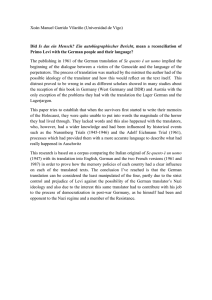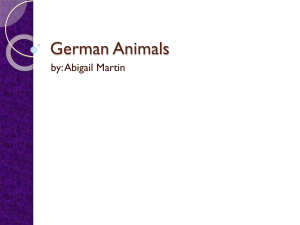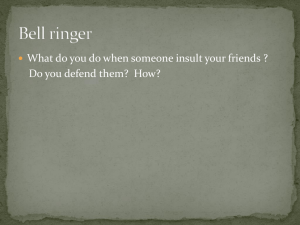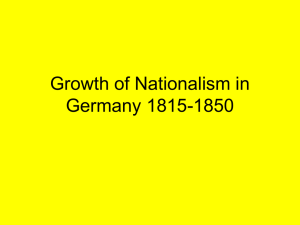PowerPoint-Präsentation
advertisement
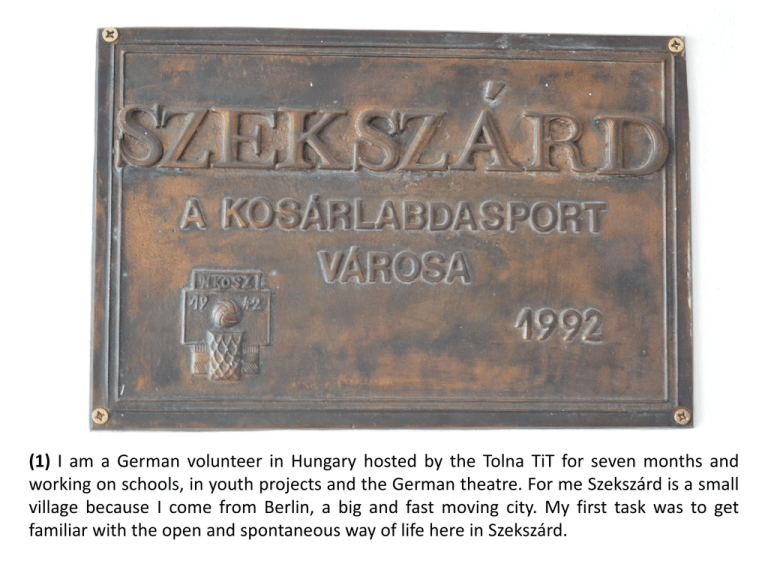
(1) I am a German volunteer in Hungary hosted by the Tolna TiT for seven months and working on schools, in youth projects and the German theatre. For me Szekszárd is a small village because I come from Berlin, a big and fast moving city. My first task was to get familiar with the open and spontaneous way of life here in Szekszárd. (2) Wineman next to Bodri étterem I opened my travel guide of Hungary before the departure and I could find just one paragraph about my new home. It was about Szekszárds famous red wine. But the wine is good. Szekszárd kept its promise. (3) Wosinsky Mór Megyei Múzeum The yellow colour is typical for many buildings in the south of Hungary. This museum on the main road of the city shows the history of the county Tolna of which Szekszárd is the administrative center. But you have to look up the opening times. As nearly all shops in Szekszárd the museum is closing around six o´clock in the evening. (4) Szent István statue on Szent István tér While walking throug the streets you can see monuments of the Hungarian history and statues in memory of the important historical figures. Mostly they are placed on squares and in little parks. As in whole Hungary also in Szekszárd big street and places are named after these personalities. (5) The Német Színház settled in the centre of the city is the only German- speaking theatre in Hungary. For the schools this stage is an important part of developing the German language. It shows international plays in German language and was my first workplace. (6) Babits Mihály Kulturális Központ The cultural centre is a distinguished place for most socio- cultural activities in the city. It organizes projects, accomodates a small cinema, offers dancing lessons for all ages, choires, rooms for celebrations, space for exibitions and presents the youth center ´Polip´ which is a place for young people to go there in their free time. (7) The Mondscheinchor As the only German choir the group is singing traditonal German chansons. Mainly consisting of seniors they gave my flatmate and me a warm welcome when we decided to join. This choir is a way to keep the German tradition in the south of Hungary. To sing in the chorus and to keep the contact to these people became a fix part of my weekly plan. (8) The faculty of the Pécs university in Szekszárd is one the very rarely signs for young life in the city. The demographic structure of Szekszárd corresponds to many small towns in Hungary: The young adolescents are settling to bigger towns because of university, more job offers or more varied cultural life. The population of the smaller cities is getting older and you have no young work power. Until now I couldn´t figure out, if the young life of Szekszárd needs a fitting inducement or if it is just existing in the university. (9) Many projects are arranged in Szekszárd. It is bringing together the kids, the youth, the adolescents and the seniors. Some topics are informing the population, sometimes the goal is having fun and some projects are aimed to integrate minorities as the Gypsy people. We as volunteers are helping in preparing these events and supervise the implementation. And in some cases we are painting the children as my flatmate is doing on the picture on a festival in September. (10) The volunteers became my friends and they showed me the supposedly only two opportunities to spend an evening: Drinking wine at home or drinking beer in a pub and go to Ést Café afterwards. I am glad that we found a few other ways of raising time. We have the Hungarian lessons together and sharing much fun while preparing activities and spending our free time together. (11) The Garáy Tér is the middle of the Szekszárd. Up to that street you can find a few restaurants where you can eat lunch cheap and delicious. One time I was reading a book here on a bench and an old man took a seat next to me. He asked something in Hungarian. After he recognized that I couldn´t understand anything except of ´Jó Nápot´ he started to talk in broken German. We made a conversation around five minutes and then his German vocabulary was emptied so he stood up, said ´Szia´ and went. I didn´t know this man, I never saw him again. But nevertheless he tried to communicate with me in any possible way. (12) The German language is common in the county Tolna. One part of my work was teaching pupils my mother tongue. Of course as a German I have many advantages here where many people can speak German. This was an obstacle while learning Hungarian if you are always switching into your mother tongue. On the other hand I was able to communicate with the persons in my environment. (13) The Gloriette on the Kilátó hill For me it is the loveliest place of Szekszárd. After climbing the stairs you have a fantastic view over the town and with good weather also the area between Szekszárd and the Danube. From that place you recognize that Szekszárd is an elongated city. But the viewpoint is also a reminder for the importance of the wine for the area. (14) The vineyards of Szekszárd Wine on the left, wine on the right, wine on the hills, wine in your glass. On the other side of the Kilátó hill out of the city you have a wonderful experience of nature through the vines and green mounds. If you are in luck you will meet a vintager who will, I am sure about this, invite you to a nice talk in his tanjá to proove the openness and friendly cordiality of an Hungarian heart in a small city.


